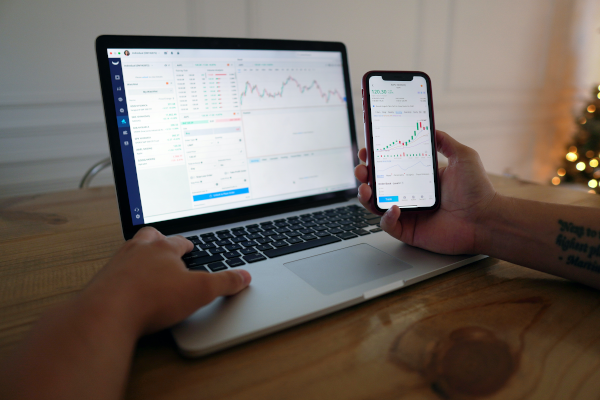How do Crypto and Forex Compare?
Over the years, a change in public attitude towards cryptocurrencies has started to take shape. Crypto used to be a fun niche interest for the more tech-savvy investors out there, and it later became a way to make online purchases and remain anonymous.
In recent years, however, all the crypto and Bitcoin news point out that traditional financial institutions such as banks, foreign exchanges, and pension funds are also widely trading in cryptocurrencies. When investing in crypto is established as a legitimate business opportunity, many financial advisors compare buying cryptocurrency and foreign currencies. In fact, some claim that crypto is a great hedge against fiat currency inflation.
Fundamental Differences
Even though it seems analogous, because investors buying currencies issued by foreign governments and buying cryptocurrencies, there are fundamental differences between the two. Unlike fiat currencies, crypto isn’t issued by any national bank and has no centralized finance structure.
What many see as benefits of Bitcoin – its decentralized nature and the ability to change based on the markets, may be seen as faults by investors. In fact, it’s sometimes easier to predict the changes in the value of traditional currencies. This is done by analyzing the country’s finances and its political sphere.
The Variety of Potential Assets
When trading forex, the investors have a set of pairs they can trade on. Twenty-one major pairs are most commonly traded, but there are also less common pairs, often including exotic currencies from developing countries. These sometimes have a quick rise and can create a significant profit.
On the other hand, trading cryptocurrencies is much broader, with many more pairs and options to consider. So-called altcoins are created daily; in many cases, they provide a service for a small but robust niche.
Volatility
The major difference between trading crypto and trading on forex exchanges comes from the fact that cryptocurrencies are much more volatile than fiat money. The value of Bitcoin was known to fluctuate dramatically in the short and middle term. However, in the long term, it’s been going up steadily.
Since the governments can react to the changes in the market via national banks, fiat currencies are much more stable. Fiat currency profits are, therefore, more incremental, steady, and lower. The decision between the two is about how risk-averse the investors are. Both options have their merit for different investors.
Profits
Both forex and cryptocurrencies are used to make a profit by relying on the changing value of a currency asset. The potential profits are very different for foreign currencies and Bitcoin. Investors can make hundreds and sometimes even thousands of percent of their initial investment when trading in crypto.
Crypto also allows for many additional income streams you couldn’t get from forex. These include mining, airdrops, staking, and lending. At the same time, foreign currencies have a much higher leverage than crypto as they have national banks behind them. Forex is, therefore, better suited to large transactions and big investors.
Risks and Leverage
There are risks involved in trading in any asset and, therefore, in crypto and forex. Some falsely claim that foreign currencies are always more stable than crypto since the government runs them. It isn’t always true because the investors also need to consider the leverage. Leverage is borrowed funds used to boost profits from trading.
In Forex trading, leverage starts from 1:100 to 1:1000. Meanwhile, in the crypto market, the leverage ratio is much smaller. For example, in Bitcoin, the leverage ratio is only in the range of 1:2 to 1:20. It’s a double-edged sword because it can increase both the profits and the losses.
Liquidity
Liquidity is another feature in which crypto and forex are different. There are many more foreign currencies than crypto, making the market more liquid. US foreign trading was US$ 7.51 trillion in 2022. The worldwide forex market capitalization in 2021 is worth $2.409 quadrillion.
It’s not easy to get these numbers for the cryptocurrency market since it’s very decentralized. However, the daily trading volume of the crypto market is only around US$ 100 billion to US$ 200 billion. This means that it’s much easier to make large transactions with forex than with crypto.
Operational Hours
Cryptocurrency markets are open 24/7, and investors can buy and sell crypto anytime. It’s a truly global market and does not depend on traditional financial structures. This allows the investors to approach the trading at their own pace and time. It’s a very liberating feature.
Forex trading is also available 24/7 but only on Monday through Friday. Some brokers may stay open over the weekend. It’s just that transactions are limited to being made with the broker; there are no other traders. Many young traders find this limiting as they are used to Bitcoin trading.
Security
There are little security risks when it comes to trading in foreign currencies. The main risk for investors is that the currency will lose value due to external factors. There’s little to no chance that the foreign exchange trade gets hacked.
However, cryptocurrency traders should be aware of security issues such as these. Many scam projects in the world of crypto are created precisely to deceive investors and obtain their personal data or even their crypto wallets. Crypto investors need to be aware of these issues and exercise caution when trading in crypto.
Regulations
There’s also an important difference in how the two are regulated. Foreign currency exchanges have been around for centuries, and there are clear rules and guidelines for operating them. However, Bitcoin and crypto exchanges are novel, and there are fewer regulations about them.
In many cases, governments have tried to apply the laws and regulations used for forex trading to crypto. That’s why the governmental agencies governing foreign currency trading also govern crypto exchanges. The tax regulations also apply to profits made from crypto in the same way they would for forex. Many investors dislike this practice as the two aren’t the same.
Is it really a Dilemma?
Trading in crypto and foreign currencies is often compared and contrasted, and there are reasons for this. Choosing between the two doesn’t have to be a dilemma for the investors. Many investors trade in cryptocurrencies and foreign fiat currencies, complementing each other.
Foreign currencies have lower yields, but they are less risky. Investing in crypto comes with higher profit margins but with more volatility. A skilled investor could use the two to hedge their bets and to get the best of both worlds. In many cases, both Bitcoin and foreign currencies can be traded on the same platform and even the same app.
Conclusion
Cryptocurrencies are now widely accepted by countless industries and traditional financial institutions such as banks, stock markets, and pension funds. This has led many to compare investing in crypto with investing in foreign currencies. Both can be done at the same exchanges and are often regulated by the same institutions, but they have their differences.
Trading in crypto is somewhat more convenient but riskier, with a chance for higher profits. Foreign currencies are more liquid as there are more of them than cryptocurrencies, but investors in crypto can buy many different pairs of currencies.





